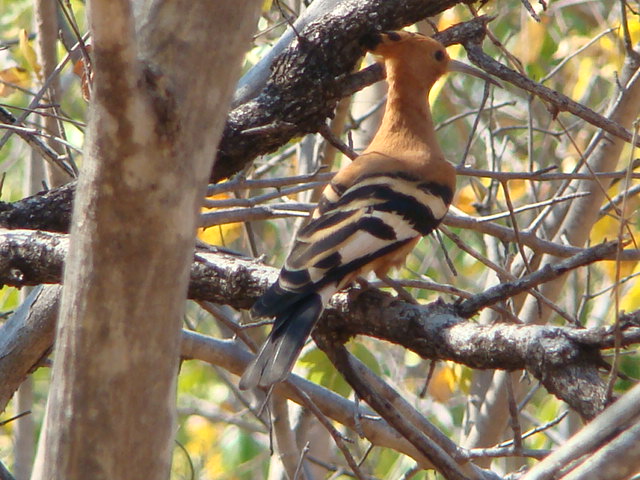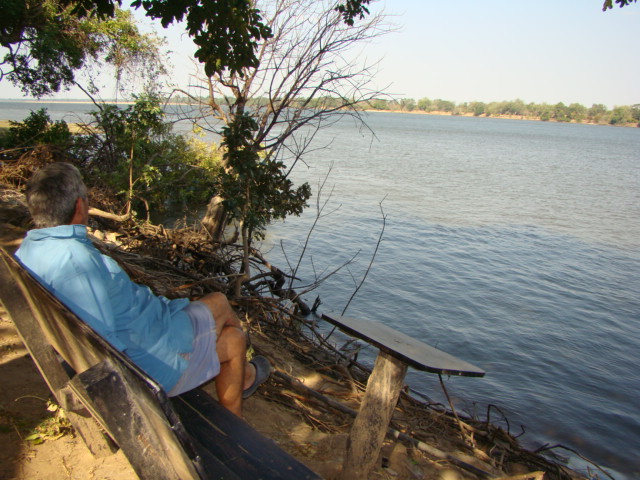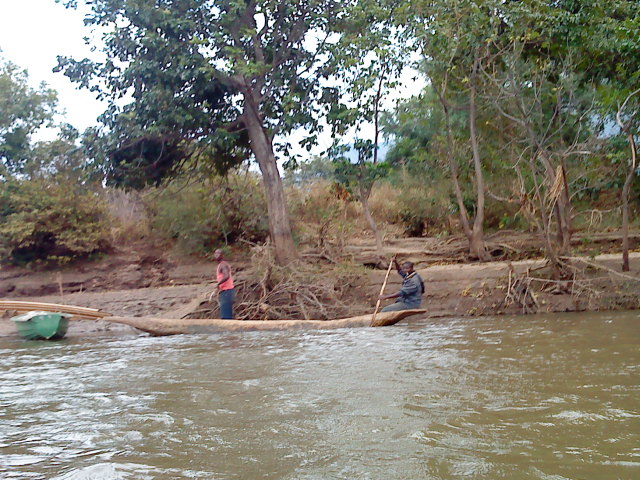This post reports on the Zambian part of our extensive MozMalZamZim trip and follows the blog post for Malawi which you saw at http://mi60malawi.blogspot.com.
This map gives you an overview of our whole trip.
The detailed map below shows you the area we covered on the day when we left Nkhotakota (Malawi), entered Zambia at Mchinji/Machinji and slept at Chipata.
That morning, we had left the sparsely populated area of Nkhotakota Forest Reserve and had driven through Kasunga and various other villages and towns on our way to Malawi border post Mchinji / Machinji.
The Zambian border post at Chipata requested us to prove that we had YELLOW FEVER INJECTIONS. As usual, we had to buy TIP and Third Party Insurance - this set us back 280,000 Zambian Kwacha (+-R426). And, as usual. we were given much help - their exchange rate compared favourably with the one in Chipata.
As the day was drawing to a close and we had driven 317km in 8 hours, we decided to sleep in Chipata which is 30km from the border.
We found Mama Rulas welcoming although our room did not have any water in the hot water tap!?! The others were luckier.
We cooked our supper over the fire next to our rooms. The next morning we did our daily Bible study and planned the day's drive.
The road ahead was really quite simple: follow the Great Eastern Road (T4) in a southerly direction as this map shows you. Where the magenta road suddenly veers south we left the T4 at Shingela to first sleep in the bush and then find the LZNP gate the following day. This map shows you two days' travel.
These were some of the memorable things we saw during our travels:
Stones next to the speed hump in a village (can you see them on the right hand side of the road?) - just in case you thought you might want to avoid the hump?!
Indigenous storage silos - work of art and practical.
Interesting outcrops of rocks.
The road stretched ahead of us as far as the eye could see - kilometers of beautiful road through beautiful countryside.
Winding down the valley towards the LUANGWA RIVER we saw a tangible reminder of the toll which travelling can claim.
Here is the beautiful bridge across the Luangwa River where we stopped to look downstream. Surely this river's water must also end up in the Cahora Bassa dam which we had visited in Mozambique?
We decided against sleeping at Bridge Camp near the bridge on Road D145 as the camping place was uninviting and the chalets expensive. So we continued west towards the LOWER ZAMBEZI NATIONAL PARK (LZNP). We knew we could enter the park from the northern side at the village SHINGELA - thanks to advice from Piet and Mariaan Kruger who managed Ana Tree Lodge (LZNP) for a year.
The sign faces to the west, we were coming from the east, so we whipped through the village without seeing the LZNP sign. Fortunately, the villagers explained where we could find the road leading south to the LZNP gate (S15 14'16.4 E029 10'04.2).
It had been a long day's trip - the 488km took us 9 hours to drive - but this was due to our own slow speed, stopping for lunch, etc. - the road was actually very good. So once we were on the dust road leading to LZNP, we decided to set up camp as soon as possible.
We bush camped (illegally?) (S15 14'50.7 E029 11'47.7) next to the rutted dust road which leads to the gate of the LZNP. The night was freezing and the dew virtually flooded our tents.
Renate found this enormous grasshopper. It was our turn to cook that night.
Breakfast early the next morning - just look at the steam (and the water wasn't even boiling yet)! The air was still freezing!
Beauty routines must be maintained! Fortunately, packing the bakkie afforded time for this.
This was Renate's space - good thing she's minute!
Wieske used these young men's request for financial support for their youth league, as an opportunity to hand out Bibles in the local language - this pleased them even more than the money we gave them!
We had to drive 17km to get to the MUKAMBA GATE of the LZNP. One of the park officials, Noah Banda (his wife, Petronella, and little Bridget) stopped us on his way to Shingela to tell us where to find Levy Banda (no relation to Noah!) - the gate keeper.
Levy lives down the road from the gate. We just needed to call him to the gate. Entrance fee (passing through LZNP): US$20pp plus US$15per vehicle. Andy and Wieske waited at the gate for us to return with Levy.
Here Mrad is giving malaria pills to Levy's sick friend.
LZNP lived up to our expectations: the Mopani forests were magnificent,
the concession areas well-managed (Njobvu watches Mrad complete the register);
the scenery was beautiful,
the mountains were breathtaking,
excellent bridges had been built (some still in progress), possibly because this road leads to a mining concession,
but the recent rains had taken their toll - we had to drive around this bridge!
The road leading to the mine was good,but we had to leave it to follow a small track to the south leading us down into the Zambezi valley. Of course, this made driving much more fun!

Even on this little used road the bridges were well-kept and the bonus was the two duikers we saw.
The track made slow driving mandatory. This gave us, the passengers, time to look around: we could actually see the ZAMBEZI RIVER snaking its way through the hazy valley below; and we had time to see birds such as this hoophoop.
We negotiated a tree that had been re-positioned by elephants,
and got seriously lost once we were out of the mountains and found too many roads and tracks on the Zambezi floodplains.
We knew that Ana Tree Lodge was the furthest lodge to the east, so we turned right at this sign.
Our compensation for getting lost? Elephants! Just look at their dried-up tracks - obviously the park is not passable during the rainy season.
Why would there be so many dead trees? Climate change? Or merely old age?
We saw some of the animals of which the park boasts: water buck, finch nests and buffalo.
The dust was as fine as powder making it difficult to follow close to the lead car, but just look how beautiful the sun's rays are in the dust! Did you know that this is how the angels change shift? Or so I believe ...
We crossed muddy crusted river beds and dry floodplains with tracks leading in all directions (??)and watched the sun set with some apprehension - we were going to miss the gate closing time!
The gate was still far and although we made haste, we enjoyed the sunset country.
When it was dark, we left the LZNP through the Chongwe Gate (long after closing time), but the guard was unperturbed after we had shown him our "just passing through" papers.
The guard kindly told us to use the two-week old new road which would take us safely to MVUU CAMP 45km away. The new road was due to the flooded conditions of the old road which was next to the Zambezi River. Thank you for telling us (!?!) - but why didn't you mention the river crossing on the new road? Read on ...
We "whipped' along at +-50km/hr in the pitch dark, only suddenly to have the road pitch us down a steep incline - due to dust, corrugation and loose stones the ABS brakes responded only slightly to each foot crunching thrust - and the truck shuddered to a stop 3m away from the CHONGWE RIVER's edge - a horrible experience! Renate ran up to the top of the incline to prevent the truck and trailer behind us from plummeting down the slope and ramming us into the river. All's well that ends well - but I now belong to a different blood group!
Although Mrad and Wieske found the right trajectory to cross the river in the dark, the general consensus was to sleep at the top of the steep slope in the only clear space on the whole road. This is how we'd pitched our tents the previous night due to the minute space cleared on the roadside (probably a road construction site!)
A hippo's grunts had woken us. We rushed to the slope leading to the river and watched the resident hippo wade out of the river to forage along the banks.
We also inspected our near-fatal slope - no picture can do justice to the angle of the slope and no-one can experience the feeling when the brakes won't brake - crunch, slide, crunch, slip, crunch, shudder to a halt - awful! Can you see where the tracks stop? Right at the river's edge!
We also watched an oncoming truck ford the river and it confirmed the choice Mrad and Wieske had made the previous evening. On their return to Mvuu Camp (where we were heading), the men told us of a truck that had headed straight across the river and that had got totally stuck later that day. It was essential to get the angle right for the river crossing!
Renate still chose to walk ahead of us - this was her first wet river crossing and she was taking no chances. She also took photos - we all made it!
We had a 25km drive to MVUU LODGE - the bush was thick and dry - mostly an uninspiring road.
We passed the new aeroplane landing site.
Due to our GPS we had no difficulty finding the camping site. We loved the mvuu (= hippo).
Mvuu Lodge was just what we needed and Troy (the manager) made us feel welcome even having supper with us during the following days.
Some of the highlights during our stay at Mvuu Lodge were:
elephants through our camp site (twice!),
a hippo mowing the lawn (can you see his pink belly?),
hot chocolate and coffee on the stoop overlooking the Zambezi River,
some relaxing: bird watching, looking at the river or planning a nap in the tent,
a boat ride on the river (will we ever get this thing pumped up),
but the elephants and hippos on the banks of the Zambezi made the effort of inflating the boat worthwhile! And just look at the sunset!
Local fishermen plying their age-old trade.
Wieske and Andy with daughter Riette - little did we know how quickly things would change!
(See obituary in http://mi60mozambique.blogspot.com).
wonderful and never-ending hot showers and wood for braais each evening.
Renate was our official fire maker (pearls and all)! Not bad for a city slicker!
Pity the monkeys were a nuisance and could only be deterred with a "kettie" or the occasional fire cracker.
Don't worry, Troy, we will be back asap!
We had to leave - the map shows you our route from Mvuu Lodge to Kariba in Zimbabwe.
On the day we left, we drove through the CHIAWA CULTURAL VILLAGE. We'll have to find out what quality gives this little village such an impressive title. Some children waved us "goodbye"!
Down the road we reached the LUANGWA PONTOON. Mr Brown is the captain and he told us that 'they' are planning to build a bridge within the next two years - what a pity as the trip was a great way to spend US$28 / R196 per vehicle.
No traffic? Watch out ...
At CHIRUNDU we met "civilisation" again - masses of trucks, milling people, noisy shebeens (taverns), rutted roads - Chirundu is a place to avoid if possible.
However, once we had taken the road to Kariba, the tar surface was good, although the drivers still had to keep their eyes open for the occasional potholes.
and the police manning the only road block merely waved us through. This drum announced the police blockade.
and the Zambian border control staff were equally friendly and helpful.
It is really great to have another point of view of our trip. You can look at Renate's Zambia photos on Facebook. Search for Renate Bussiahn.
Click on "photos" and select "Africa Trip: Part Three 3-8 July"
https://www.facebook.com/media/set/?set=a.10150239616536455.312341.624021454
Zambia was a great experience although we realized that we had only seen one of the attractions that Zambia has to offer. Of course, we'll be back!
Please read about our travels (and travails) in our next post
http://www.mi60zimbabwe.blogspot.com.
We would love you to comment on our blog too.


























































































